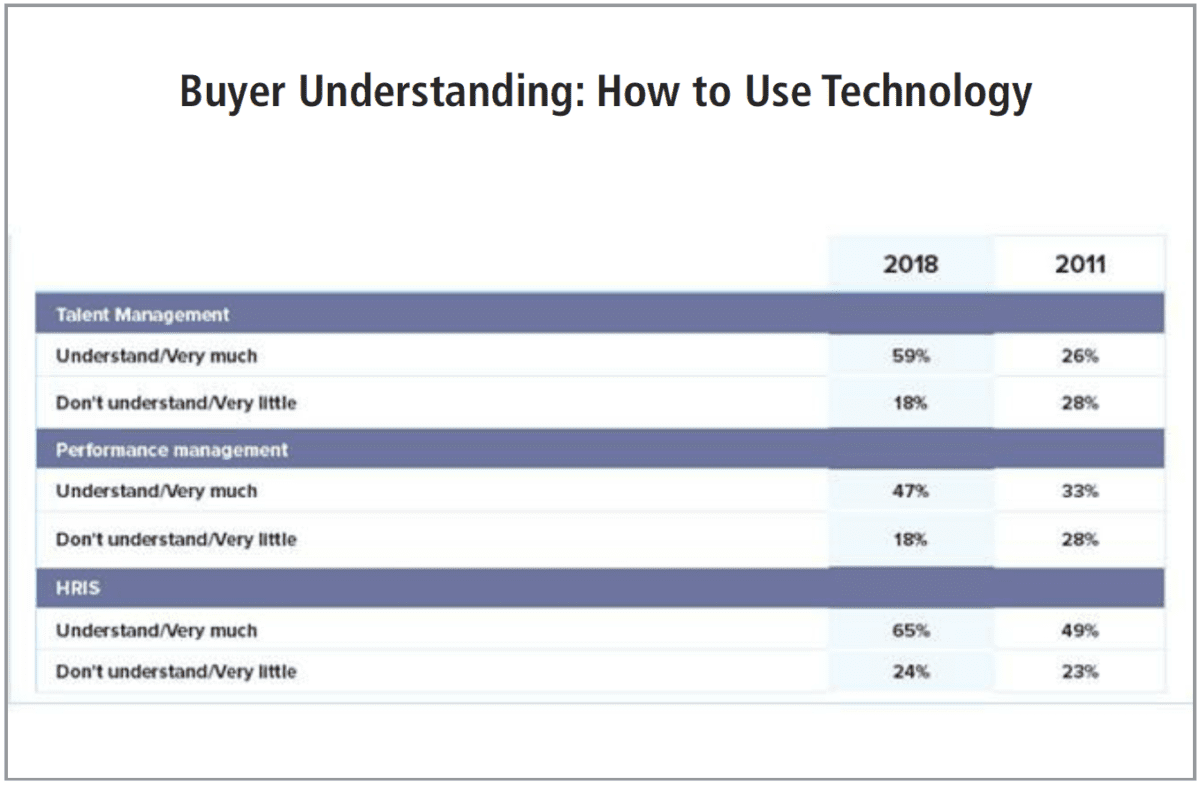New research indicates that HR service partners and practitioners have different viewpoints about HR technology.
By Larry Basinait
Innovations in artificial intelligence (AI) and analytics, along with developments in cloud, social, and mobile technologies, are making HR systems more intelligent and more engaging. In fact, HRO Today research shows that in just the first three quarters of 2018, there have been over 125 significant product announcements worldwide in the industry. Not only are there an exploding number of core cloud-based HCM systems, but billions of dollars are now being invested in new tools for recruitment, performance management, engagement, training, diversity and inclusion, analytics, well-being, and more.
But with the growth of so many new systems and tools, are HR service partners offering innovation that HR practitioners want or even use? Or are systems becoming too complex and more focused on gadgets and buttons than workflow capacity improvements?
In 2011, HRO Today posed this question to its readers and membership base and found that there was a disconnect between what HR service partners thought they were delivering versus what HR leaders believed they were getting. A new study reexamines attitudes to see if they have changed over the last seven years and identifies the areas most impacted by technology innovation.
In order to determine how HR leaders’ and HR service partners’ viewpoints about technology innovation’s impact on HR practices have changed, HRO Today surveyed HR professionals who use a variety of HR solutions from a broad spectrum of service partners. The study is sponsored by Lumesse, a leading international provider of SaaS talent management and talent acquisition solutions. Where appropriate, results are compared to relevant sections of the first edition of the study conducted in 2011. In total, 100 respondents participated in the survey from the HRO Today magazine subscriber list, e-newsletter mailing list, and HRO Today Services and Technology Association.
A Closer Look
When the first edition of this study was completed in 2011, the prevailing conclusion was clear: HR practitioners and technology service partners were far apart with respect to their attitudes about HR technology offered in the marketplace. At that time, HR service partners considered the technology they offered far more important, more innovative, and more applicable to HR workflows and used more by key stakeholders than HR leaders.
In 2018, that perception largely remained in place, though the gap between the views of the two groups across each measure has narrowed considerably. Technology innovation is considered important by the vast majority of study participants, both service partners and HR practitioners. Technology is transforming how HR operates, and it couldn’t do that without considerable respect for the innovation being employed. But there is a difference in opinion regarding its importance across talent management applications, performance management, and HRIS. Technology providers are offering innovation but HR leaders aren’t as enthusiastic about the specific functionality as service partners.
There is also another difference of opinion between service partners and practitioners when it comes to the question of whether new technologies are truly innovative. HR service partners are far more likely to believe in their own technology innovation prowess across talent management, performance management, and HRIS systems than are HR leaders. The extent of this difference in opinion has narrowed since 2011, but that difference still remains significant.
Workflow applicability also impacts opinions about technology innovation. In 2018, three-quarters (75 percent) of service partners overwhelmingly indicated that they thought the talent management innovations were directed toward workflow impact compared to only about one-third (37 percent) of practitioners. Opinions about performance management and HRIS technology followed a similar pattern. HR leaders don’t necessarily feel the focus of innovation is on workflow.
 HR service partners counter that too many HR practitioners don’t understand how to use the talent management and performance management technology they offer, though they’ve become more knowledgeable since 2011. Two-thirds of tech partners now state that HR leaders know how to use HRISs, up from less than one-half (49 percent) in 2011.
HR service partners counter that too many HR practitioners don’t understand how to use the talent management and performance management technology they offer, though they’ve become more knowledgeable since 2011. Two-thirds of tech partners now state that HR leaders know how to use HRISs, up from less than one-half (49 percent) in 2011.
Service partners might gain buy-in for new technology usage more easily by consulting with practitioners about how their business strategy aligns with their use of technology. Less than one-quarter of practitioners feel that they are consulted with often. Soliciting input and collaborating more with service partners might lead to greater acceptance that the innovations being made are applicable to workflow. Further, there could be a greater use of the product functionality for non-HR staff like candidates, hiring managers, and line managers if their needs and expectations were included in product design.
But despite a mostly critical evaluation from practitioners about HR technology innovation, survey respondents almost universally believe that technology has had a major impact on them over the last three years. Reporting, cloud-based infrastructure, and core functionality were considered most impacted areas.
Technology innovation means change, and change is hard. HR professionals are getting an increasing amount of technology that they never had to use before and they’re being asked to provide analytic abilities they never were required to have. Traditional soft skills owned by HR departments are still needed, but now there’s a growing analytic component. HR teams are trying new tools, experimenting with new performance management models, adopting new learning technologies, and just doing creative things like never before. HR departments are learning to use new performance management models and new learning strategies and new techniques for talent acquisition.














